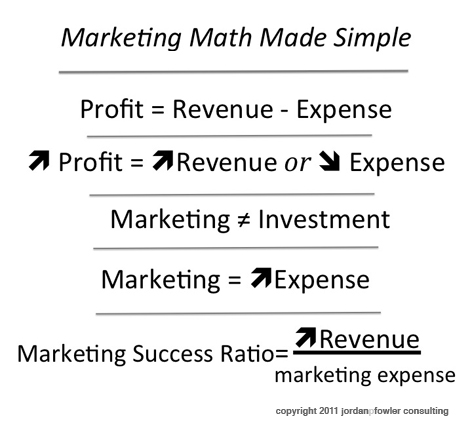(or How To Stop Believing Marketing Gibberish)
Use this Marketing Math Made Simple chart to improve your marketing efforts by bringing them into the real, harsh world of P&L, expenses, and cashflow. The mere mention of these terms gives marketers the willies, yet this is what keeps business owners up at night.
Here is Marketing Math Made Simple:

Profits, Revenue and Expenses
The goal of business is to make a difference in the world while earning maximum profit. I know some forgo the “make a difference world” piece; they shouldn’t. The only way to increase profit is 1) increase revenue or 2) decrease expenses.
Marketing is not an investment.
While many marketers will use the term return on investment when referring to marketing, in its truest sense, this is incorrect. In an investment, you place principal into things–stocks, businesses, oil wells–that return dividends on the leverage of your principal. At the end of the investment, you earn back your principal plus dividends (unless it all went south, of course). The object invested in can be sold if necessary to get a return of principal–house, oil well, stocks. This is not how marketing works.
Marketing is an expense.
When you buy a print ad, radio spot, or Facebook ad, your “principal” is forever gone. You cannot resale the ad or spot. Good business owners realize marketing is a necessary expense of doing business–like a computer, or staff, or stationery. It is tempting for marketing people to try to sell their services as an investment. “Would you like to invest in your business?” sounds like a much better selling point than, “Would you like to incur some new expenses?”But better-pitch-point does not equal true.
Some expenses are good expenses.
Buying new computers when your old ones won’t compute the task at hand without smoking, sputtering and wasting time, good expense. Spending money on new staff when your current staff is overloaded and you’ve tried less expensive efficiency tools (project management software, shock collars, etc.), good expense. Staying in a five-star hotel on business trips, bad expense. Good expenses open up the funnel of potential business growth and reduce the bottleneck of inefficiency. Bad expenses are silly.
Profit is the true measure.
The crux of Marketing Math Made Simple is that profit should increase at a greater rate than the associated marketing expenses. Granted it will take time for marketing to have affect. Some marketers and business owners will allow marketing expenses to accumulate ad infinitum without ever seeing a increase in profit. If so, marketing becomes a bad expense.
How We Use Marketing Math in Our Approach at Jordan P. Fowler Consulting
If you spend any time around us, you will quickly pick up on our evidenced based business development and marketing approach. While we may use the terms “brand awareness,” “increased followers” and other marketing speak, we realize they are never the end game.
The only measure of successful marketing is INCREASED PROFITS resulting from a growth of revenue that outpaces marketing expenses incurred.
1. We conduct a BeFogFree exercise.
This provide incredible clarity of your unique core values and make key business model adjustments before amplifying your core uniqueness through marketing. (Read more on BeFogFree).
2. We establish a clear “You are Here” profit metric.
We determine your present metric of profit, revenue, and expenses. If this is not known, progress cannot be measured.
3. We conduct an efficiency study to reduce expenses and eliminate headaches.
We assess your current business systems and processes, making efficiency recommendations to reduce operating expenses and ready you for increased growth as a result of your marketing. This helps eliminates those nagging business headaches.
4.We set marketing budgets together.
We sit down with you to determine what market expenses you can incur that make good sense based upon our marketing research (consumer, competitor, etc.) allowing us to finance the best marketing strategies possible.
5. We share your comprehensive strategic report.
The results of 1-5 are presented to you in our Comprehensive Strategic Report including our BeFogFree findings, Headache Eliminators, and Value Amplifying marketing strategy. At this time we set an official date for a formal progress review to see if your Marketing Success Ratio has increased and by what degree. Rest assured that we are monitoring this throughout the process
6. We execute the marketing strategies, amplifying your value.
Upon your approval we create the need marketing products (ads, website, social media sites, etc) measuring and tracking results in partnership with you and your staff. We take your unique, distinct value and crank it to 11 for the world to hear.
7. We do our formal review.
This is where the evidence that your marketing is working becomes empirically clear . We analyze your initial Marketing Success Ratio versus current Marketing Success Ratio versus our goal for improvement in the ratio.
a. If the desired improvement in the ratio is not achieved, we check to see if more leads have been generated. If they have, we work with you to close the breakdown gap on your end with customer service staff training, additional operations analysis, etc.
b. If you haven’t received more leads, we can adjust or marketing strategies or we invite you to fire us! Not many marketing agencies will give you that invitation–we do.
8. We repeat steps 3-7.
We invite you to call us at 817-889-1487 to set up a free consultation to see how our proven business development and marketing process can increase your profits and provide you more peace of mind and sanity.


